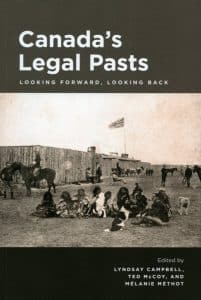Campbell, Lyndsay, Ted McCoy, and Mélanie Méthot, eds. Canada’s Legal Pasts: Looking Forward, Looking Back. Calgary: University of Calgary Press, 2020.
In 1973, Professor of Law, R.C.B. Risk, presented “A Prospectus for Canadian Legal History” at Dalhousie Law School, which was subsequently published in the Dalhousie Law Journal. In this paper he suggested that “an understanding of history cannot be complete without some understanding of its legal elements.”[1] When Risk wrote his paper, Canadian legal history was very much in its infancy. While legal scholars focused on the history of legal principles and institutions, historians viewed the law as something tangential to historical analysis.
Over the following four decades, interest in Canada’s legal past has produced a wide array of studies that have explored various institutional legal histories from across the country, including family law, criminal law and policing, business law, and human rights. In the first volume of Essays in the History of Canadian Law, published in 1981, legal scholar, and the volume’s editor, David H. Flaherty wrote “a meaningful legal history should…do more than simply illuminate the internal history of a topic.” It was evident that legal history needed to move beyond a one-dimensional review of its inner characteristics and more fully examine the relationship between law and society. As the law does not exist in a vacuum, neither should our review of its history.
Canadian history has, for the most part, overlooked the country’s legal past. Some legal scholars have suggested that historians are intimidated by the law. They claim historians do not have the intimate knowledge of complicated legal principles and are unable to advance a proper treatment of Canada’s legal heritage.[2] This explanation, however, may be too simplistic. Early legal history was more descriptive than analytical and more internal than external. The ahistorical nature of early legal history made it inconsequential for some historians.[3] Legal scholars and historians often have different objectives for legal sources, but also different methodologies. The former used the past as precedent to explain a contemporary issue without considering the historical context. A more descriptive method presenting a clear, direct link between past and present was often lacking. Historians are often more interested in change and they strive to illustrate how historical context is relevant. As Barry Wright suggests, “[history] does not use the past. It studies it.”[4]
As historians began to appreciate the historical value of legal documents, legal history developed further. The interrelationship between law and society became more significant and scholars recognized that law affects society as much as society affects law. It became a given that good Canadian history must include the country’s legal history. Since the 1970s, scholars have shown just how significant legal history is to understanding Canada’s past via excellent studies showing the relationship between the law and economics and business, politics, society, and culture. No longer is there a dispute about the centrality of law to legal history. It goes without saying that when the focus of legal history shifts from the internal to the external, when outside cultural, social, political, and economic forces are considered, one need not necessarily have a law degree.
A recent collection of essays, based on a legal history conference at the University of Calgary in 2017, shows the significant progress that has been made in writing about legal history since Risk wrote his Prospectus. The essays in the collection reflect how old methodologies are inspiring new opportunities for studying Canada’s legal past. The book brings experienced academics together with emerging scholars to examine the past while also focusing on the future. The editors write, “[b]y foregrounding Canadian legal history’s rich array of sources, methodologies, and questions, this book not only marks the maturity of the field but also aims to welcome new scholars and new contributions.”
The collection of essays is an example of the future of legal history writing in Canada. Organized thematically into three sections, the essays explore the law beyond the narrow confines of doctrine and institutions and the authors illustrate how the law can expand understanding of other areas of history.
In 1973, Risk wrote, “…we know almost nothing about our legal past. We have not even accumulated and organized most of the major facts, let alone thought out them.”[5] How do we continue to move forward exploring Canadian legal history? This book illustrates the progress made in finding Canadian legal history. From various perspectives, the authors examine family law, bigamy, penitentiary history, the Judicial Committee of the Privy Council, New France, the North West Mounted Police, and human rights. The essays survey Atlantic Canada, Western Canada, Upper Canada, Quebec, and Canada’s connection to England. There is one glaring omission, acknowledged by the editors in the Introduction, which certainly offers an opportunity for future authors. Indigenous law is only touched upon in a few of the essays, and the topic lacks deep analysis of one of the traditional pillars of the country’s legal system. As a result of this omission there remains an opportunity to study, research and write legal history from an Indigenous perspective using Indigenous scholars and academics.
The first section reviews interesting cases in Canadian legal history by making use of both traditional archival and digital sources. These sources are used to explore the subject matter from different perspectives. Eric H. Reiter examines judicial records for his chapter exploring family defamation in Quebec Civil Courts. He suggests that by using the available case files, which are rarely accessed, historians are able to acquire a better sense of the process of litigation. Reiter argues that when these vital records have been accessed they can be used to flesh out legal arguments, which would not be available in published reports. Ted McCoy, in his essay on the history of the penitentiary system, emphasizes that online sources make reevaluating established penitentiary history, along with new interpretations, much simpler. For example, there are gaps in the traditional source material, such as records relating to female and Indigenous inmates. An opportunity exists, with greater access to legal and non-legal materials, to expand on the long-established histories.
The Internet has changed how historians research and access archival records. Digitization projects in archival repositories worldwide have made it significantly easier, and cheaper, to access primary source documents. Newspapers have always been a useful source for understanding society. Mélanie Méthot makes use of newspaper accounts in studying bigamy cases, but cautions that researchers must always contextualize their sources. Lyndsay Campbell also uses newspapers, as well as pamphlets which can be particularly useful as they are often written by someone close to or involved in the legal action. In this way they are an excellent source outside the official records. Of course such sources as newspapers and pamphlets must be contextualized in their socio-historical environment.
Two essays in the volume deal with the political and diplomatic issues surrounding the confiscation of the American fishing schooner, the Frederick Gerring Jr. Both authors outline the relationship between politics and the law. Christopher Shorey examines the British and American “memorials” to further understand the confiscation of the Gerring to the Supreme Court decision, intertwined with the behind-the-scenes diplomatic pressures being placed on the Dominion government. Angela Fernandez also explores the Gerring incident, but from a different set of sources. Her focus is not on the episode specifically, but how James Kent’s Commentaries were used to determine property. It is useful to read both of these essays together to gain a better understanding of the Gerring incident from different perspectives and sources.
The second section investigates the influences of outside legal regimes on Canada’s pluralistic system. The Judicial Committee of the Privy Council played a major role in the development of Canada’s constitutional system, and several significant cases are examined. In her essay, Catherine MacMillan searches the archives to explore the role of the Privy Council beyond its constitutional duties. These records, she argues, are potentially important for a wide-ranging number of projects inside and outside the law.
The second major national influence on Canada’s legal system stems from the French Civil Code. Alexandra Havrylyshyn examines primary sources from France and Quebec in order to reconsider the narrow definition of a lawyer in New France. The author points out the importance of contextualizing language to ensure that a modern definition of lawyer is not used when assessing the role of lawyers in New France. The history of the North-West Mounted Police (NWMP) is well known and it has been central to the folklore of prairie settlement. Shelley A. M. Gavigan is the latest to study the history of the NWMP. Many have focused on the original objective for the policing efforts of the NWMP. However, Gavigan uses the archival records to examine the relationship between criminal justice and police discipline from the perspective of what she calls “low law”.
The final section considers the future of legal history studies in Canada. The history of human rights in Canada is a new subject of research in the law. Dominique Clément’s essay on the history of unequal treatment of women in Canada details the importance of human rights legislation. He uses primary sources documents, coupled with the pervasive research on sex discrimination, to survey what he refers to as the three stages of legal reform: equal citizenship, formal legal equality and human rights law. Clément concludes that human rights is a better way to achieve equality over the more forceful use of the law.
If Canada’s legal history is considered relatively young, the history of prairie legal history is even younger. Like national legal history, prairie legal history is largely dependent on the internal records created by various legal authorities and institutions. In the final essay, Louis A. Knafla explores the development of this unique legal history. He examines the entrenched relationship between law and society and its influence on the evolution of legal history. Knafla concludes that the relationship between law and society must direct the future of legal history when considering unexplored themes and subjects.
This volume is an excellent source for emerging legal history scholars and academics. Each essay is well written and easily accessible by the non-specialist in legal history. The collection covers a wide array of subjects and each author details the sources in great detail. The editors include a detailed Bibliography that lists the archival repositories used in each chapter. Legal history in Canada has made tremendous progress since the early 1970s. While there is still much work to be done, especially with regards to Indigenous legal traditions this collection of essays is a positive step in the right direction.
[1] R.C.B. Risk, “A Prospectus for Canadian Legal History,” Dalhousie Law Journal vol. 1, no. 2 (1973): pg. 227.
[2] André Morel, “Canadian Legal History: Retrospect and Prospect,” Osgoode Hall Law Journal vol. 21, no. 2 (September 1983): pg. 162-63.
[3] Barry Wright, “Towards a New Canadian Legal History,” Osgoode Hall Law Journal vol. 22, no. 8 (Summer 1984); pg. 361.
[4] Ibid., pg. 360.
[5] Risk, “A Prospectus for Canadian Legal History,” pg. 227.





